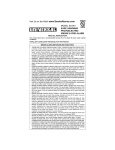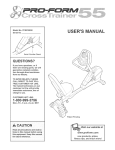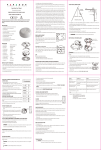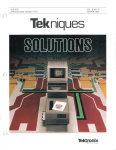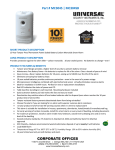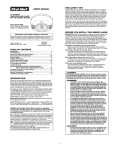Download Universal Security Instruments SS-2895 User's Manual
Transcript
Visit Us on the Web! www.SmokeAlarms.com
MODEL SS-2895
EARLY WARNING
PHOTOELECTRIC
SMOKE & FIRE ALARM
WITH SILENCE CONTROL
READ ALL INSTRUCTIONS
The smoke alarm has a recommended service life of at least 10 years under normal
conditions.
INSTALLER: PLEASE LEAVE THIS MANUAL WITH THE PRODUCT.
SMOKE ALARM LIMITATIONS AND FUNCTIONS
• THERE ARE TWO BASIC SMOKE ALARM TYPES - IONIZATION AND PHOTOELECTRIC.
Ionization smoke alarms are your best overall choice for reliability and fast response
time, since they quickly sense small "invisible" smoke particles and will also sense
larger "visible" smoke particles. Photoelectric smoke alarms may respond more quickly
in certain types of fires, for example - slow smoldering fires with large "visible" smoke
particles. ALL TYPES OF SMOKE ALARMS HAVE LIMITATIONS. NO TYPE OF SMOKE
ALARM CAN SENSE EVERY KIND OF FIRE OR SMOKE EVERY TIME.
• WARNING - SMOKE ALARMS WILL NOT WORK DURING A LOSS OF POWER. SINCE A
SMOKE ALARM WILL NOT WORK WITHOUT POWER, having an alarm(s) that works from two
completely different power sources, such as an AC direct wire with battery backup smoke
alarm, can give you an extra measure of protection in case of an AC power failure or a dead
battery.
• USING A SMOKE ALARM IN A SMOKY AREA LIKE A KITCHEN, OR IN A HIGH HUMIDITY
AREA NEAR A SHOWER, CAN CAUSE FALSE ALARMS. DO NOT TURN OFF THE AC
POWER TO QUIET THE ALARM. A SMOKE ALARM WILL NOT HELP PROTECT YOU IF IT
IS NOT POWERED. Properly locate your alarm to avoid nuisance alarms.
• A SMOKE ALARM MAY NOT ALWAYS WARN YOU ABOUT FIRES CAUSED BY CARELESSNESS
AND SAFETY HAZARDS LIKE SMOKING IN BED, VIOLENT EXPLOSIONS, ESCAPING GAS,
IMPROPER STORAGE OF FLAMMABLE MATERIALS, OVERLOADED ELECTRICAL CIRCUITS,
CHILDREN PLAYING WITH MATCHES, NATURAL CAUSES SUCH AS LIGHTNING, OR ARSON.
FIRE PREVENTION IS YOUR BEST SAFEGUARD.
• INSTALLING SMOKE ALARMS MAY MAKE YOU ELIGIBLE FOR LOWER INSURANCE
RATES, but SMOKE ALARMS ARE NOT A SUBSTITUTE FOR INSURANCE. Homeowners
and renters alike should continue to insure their lives and properties.
• SMOKE ALARMS CANNOT WORK WITHOUT POWER. Battery operated units cannot work if
the batteries are missing, disconnected or dead, if the wrong type of batteries are used or if the
batteries are not installed correctly. AC (only) powered units cannot work if the AC power is cut
off for any reason. If you are concerned about the limitations of battery or AC power, install both
types of units.
• SMOKE ALARMS CANNOT DETECT FIRES IF THE SMOKE DOES NOT REACH THEM.
Smoke from fires may not reach the sensing chamber and set off the alarm. One unit
should be installed inside each bedroom or sleeping area.
• SMOKE ALARMS MAY NOT DETECT FIRE ON ANOTHER FLOOR OR AREA OF THE
HOME. Recommended minimum protection is at least one unit in every sleeping area
and every bedroom on every level of your home. Interconnected units may provide earlier
warning than stand-alone units since all units alarm when one detects smoke.
• SMOKE ALARMS MAY NOT BE HEARD. The alarm horn in this unit meets or exceeds
current standards, but it may not be heard if: (1) the unit is located outside a closed or
partially closed door; (2) residents recently consumed alcohol or drugs; (3) the alarm is
drowned out by noise from stereos, TV's, air conditioners or other appliances or (4) if
residents are hearing impaired or sound sleepers.
• SMOKE ALARMS ARE NOT FOOLPROOF. You must test the unit weekly to ensure your
continued protection. Smoke alarms cannot prevent or extinguish fires.
• SMOKE ALARMS HAVE A LIMITED LIFE. The unit should be replaced immediately if it is
not operating properly. You should always replace a smoke alarm after 10 years.
• SMOKE ALARMS ARE NOT TO BE USED WITH DETECTOR GUARDS UNLESS THE
COMBINATION HAS BEEN EVALUATED AND FOUND SUITABLE FOR THAT PURPOSE.
• CURRENT STUDIES HAVE SHOWN SMOKE ALARMS MAY NOT AWAKEN ALL SLEEPING
INDIVIDUALS AND THAT IT IS THE RESPONSIBILITY OF INDIVIDUALS IN THE
HOUSEHOLD WHO ARE CAPABLE OF ASSISTING OTHERS TO PROVIDE ASSISTANCE
TO THOSE WHO MAY NOT BE AWAKENED BY THE ALARM SOUND OR TO THOSE
WHO MAY BE INCAPABLE OF SAFELY EVACUATING THE AREA UNASSISTED.
RECOMMENDED LOCATION OF ALARMS
• Locate the first smoke alarm in the immediate area of the bedrooms. Try to protect the escape
route as the bedrooms are usually farthest from an exit. If more than one sleeping area exists,
locate additional smoke alarms in each sleeping area. If a hall is more than 40 feet (12 meters)
long, install a smoke alarm at each end.
• Locate additional smoke alarms to protect any stairway as stairways act like chimneys for
smoke and heat.
• Locate at least one smoke alarm on every floor level.
• Locate a smoke alarm in any area where a smoker sleeps or where electrical appliances are
operated in sleeping areas.
• Smoke, heat and other combustion products rise to the ceiling and spread horizontally. Mounting
the smoke alarm on the ceiling in the center of the room places it closest to all points in the room.
Ceiling mounting is preferred in ordinary residential construction. However, in mobile homes, wall
mounting on an inside partition is preferred to avoid the thermal barrier that may form at the
ceiling.
• When mounting smoke alarm on the ceiling, locate it a minimum of 4" (10cm) from a side wall
or corner (see Diagram A).
• When mounting smoke alarm on a wall, if local codes allow, use an inside wall with the top edge
of the smoke alarm a minimum of 4" (10cm) and a maximum of 12" (30.5cm) below the ceiling/
wall intersections (See Diagram A).
Existing Homes:
The NFPA requires a smoke alarm on every level and outside each sleeping area in existing construction. An
existing household with one level and one sleeping area is required to have one smoke alarm.
New Construction Homes and Manufactured Homes:
The NFPA requires AC-powered, interconnected smoke alarms to be installed inside each bedroom, outside each
bedroom area, and on every level of the home. They also require a minimum of two AC-powered, interconnected
smoke alarms in any new construction home.
Sloped Ceilings (Peaked Ceilings):
Smoke alarms or smoke detectors mounted on a peaked ceiling shall be located within 36 in. (914 mm) horizontally
of the peak, but not closer than 4 in. (102 mm) vertically to the peak.
Sloped Ceilings (Shed Ceilings):
Smoke alarms or smoke detectors mounted on a sloped ceiling having a rise greater than 1 ft. in 8 ft. (1 m in 8
m) horizontally shall be located within 36 in. (914 mm) of the high side of the ceiling, but not closer than 4 in. (102
mm) from the adjoining wall surface.
Tray-Shaped Ceilings:
Smoke Alarms or smoke detectors shall be installed on the highest portion of the ceiling or on the sloped portion
of the ceiling within 12 in. (305 mm) vertically down from the highest point.
Mobile Home Installation:
For minimum protection, smoke alarms should be installed in compliance with H.U.D. Manufactured Home
Construction Safety Standards, Title 24 CFR, Section 3280.208 and Section 3282. For additional protection, see
Single Story Residence smoke alarm requirements/recommendations for Existing Homes and New Construction
Homes.
Note: For mobile homes built before 1978, install smoke alarms on inside walls between 4” and 12” from the
ceiling (older mobile homes have little or no insulation in the ceiling). This is especially important if the ceiling
is unusually hot or cold.
Install a smoke alarm inside each bedroom and in the hallway outside each separate sleeping area.
Page 2
AVOID THESE LOCATIONS
• the garage – products of combustion are present when you start your automobile.
• near appliances or areas where normal combustion regularly occurs (kitchens, near furnaces,
gas hot water heaters). Use smoke alarms with Silence Control for these areas.
• in areas with high humidity, like bathrooms or areas near dishwashers or washing machines.
Install at least 3 feet (0.9 meters) away from these areas.
• in areas of turbulent air such as air returns or heating and cooling supply vents, smoke alarms
shall not be located where airflow prevents operation of the alarms.
• in extremely dusty, dirty or insect-infested areas. Loose particles interfere with smoke alarm operation.
• in areas where temperature may fall below 400F (4.40C) or rise above 1000F (37.80C).
• closer than 1 foot (0.3m) from fluorescent lights, electrical "noise" and flickering may affect the
alarm's operation.
• closer than 3 feet (0.9m) horizontal path from the tip of the blade of a ceiling suspended (paddle) fan.
• on a poorly insulated ceiling or exterior wall (mount smoke alarm on an inside wall).
THIS SMOKE ALARM WILL NOT WORK WITHOUT 120 VAC POWER AND A
GOOD BATTERY PROPERLY INSTALLED. THE SMOKE ALARM SHOULD BE
TESTED WHEN INSTALLED AND THEN TESTED WEEKLY AFTER THAT.
FALSE ALARMS
The smoke alarm is designed to minimize false alarms. Smoking will not normally set off the alarm
unless smoke is blown directly into the smoke alarm. Combustion particles from cooking may set off
the alarm if the smoke alarm is located close to the kitchen cooking surface. Large quantities of
combustion particles are generated from spills or broiling.
If the smoke alarm does sound, check for fires first. If a fire is discovered, get out and call the fire
department. If no fire is present, check to see if one of the reasons listed above may have caused
the alarm. Use the "silence" feature if it is a false alarm.
INSTALLATION AND OPERATION
INSTALLATION INSTRUCTIONS: CAUTION!! READ CAREFULLY.
CAUTION: THIS UNIT IS SEALED. THE COVER IS NOT REMOVABLE!
• A mounting plate is provided on the back of the alarm.
• Remove the mounting plate from the back of the alarm by holding the mounting plate and twisting
the alarm in the direction indicated by the "TURN TO REMOVE" arrow on the side of the alarm
base.
Installation of this unit must conform to the electrical codes in your area; Article 760 of the
National Electrical Code, NFPA 72, 101; SBC (SBCCI); UBC (ICBO); NBC (BOCA): OTFDC
(CABO), and any other local or building codes that may apply. Wiring and installation must be
performed by a licensed electrician. Failure to follow these guidelines may result in injury or
property damage.
This unit must be powered by a 24-hour, 120V AC 60Hz circuit. Be sure the circuit cannot be
turned off by a switch, dimmer or ground fault circuit interrupter. Failure to connect this unit
to a 24-hour circuit may prevent it from providing constant protection.
IMPORTANT: Do not subject this smoke alarm to megger, high voltage or high-pot tests.
Remove the smoke alarm(s) before high-potting tests occur on the circuit or system.
(Ref. Section 550-17, National Electric Code, 2002 Edition).
ELECTRICAL SHOCK HAZARD
Turn off power to the area where you will install this unit at the circuit breaker or fuse box
before beginning installation. Failure to turn off the power before installation may result in
serious electrical shock, injury or death.
TAMPER LOCKING PIN: To make your alarm somewhat tamper resistant, a locking pin has been
provided. Using this pin will deter children and others from removing the alarm from the mounting
plate. To use the pin, insert it into the hole in the side of the alarm after it has been installed on the
mounting plate. Using long nose pliers, pull the pin out of the hole. It is now possible to remove the
alarm from the mounting plate.
1.
Turn the alarm counterclockwise in the direction indicated by the "TURN TO REMOVE" arrow
on the side of the alarm base to remove it from the mounting plate. NOTE: The alarm is sealed
and the cover is not removable.
Page 3
2.
Wiring Instructions:
a.
The appropriate power supply is 120 Volt single phase power supplied from a non-switchable
circuit NOT protected by a ground fault circuit interrupter.
b.
Turn off main power to the circuit before wiring the smoke alarm.
c.
There are three pigtail leads (black, white and yellow) coming from the AC QUICK
CONNECTOR. The proper wire connection is as follows:
WIRES FROM QUICK CONNECTOR
BLACK
WHITE
YELLOW
CONNECT TO
"HOT" side of AC line
"NEUTRAL" side of AC line
Interconnect wires of other units
For units that are used as single smoke alarms, do not connect the yellow wire to anything.
Insulate this wire (tape it) in place to make certain the yellow wire cannot contact any metal
parts.
Interconnected units can provide earlier warning of fire than stand-alone units, especially
if a fire starts in a remote area of the dwelling. This smoke alarm may be interconnected
with as many as 11 other UNIVERSAL model smoke alarms such as SS-785, SS-790, SS-795,
SS-2795, SS-2895 and 6 other units which may be a combination of Carbon Monoxide
Alarms such as CD-9385, CD-9390, CD-9485, CD-9490, CD-9795, Heat Alarms/HD-130 or
Relay Modules/RM-100 for a total of not more than 18 interconnected devices.
Interconnected CO alarms will only respond if a CO alarm / event initiates the alarm. All
other alarms remain silent.
Interconnected smoke alarms, heat alarms and relay modules will only respond if a smoke
alarm / event or heat alarm / event initiates the alarm. All CO alarms remain silent.
Note that units without battery backup will not respond during an AC power failure.
NOTE: Relay Modules/RM-100 will not respond if a CO alarm / event initiates the alarm.
INPUT:
120 VAC
60 HZ
.05A
The yellow wire is used only for multiple station operation with UNIVERSAL Model alarms
only. Connecting this yellow wire to any other circuits may result in damage. When alarms
are interconnected, all units must be powered from a single AC branch circuit. If local
codes do not permit be sure the neutral wire is common to both phases. The maximum
wire run distance between the first and last alarm/device in an interconnected system is
1,000 feet. NOTE: Use standard household wire (18 gauge or larger, rated at least 300V, as
required by local codes) available at all electrical supply/hardware stores.
The wiring to be used shall be in accordance with the provisions of Articles 210 and
300.3(B) of the National Electrical Code, ANSI/NFPA 70. In addition, the resistance of the
interconnecting wiring shall be a maximum of 10 Ohms.
Early warning fire detection is best achieved by the installation of fire detection equipment
in all rooms and areas of the household as follows: A smoke alarm installed in each
separate sleeping area (in the vicinity of, but outside of, the bedrooms) and heat or smoke
alarms in living rooms, dining rooms, kitchens, hallways, attics, furnace rooms, closets,
utility storage rooms, basements and attached garages. Test the smoke alarm weekly to
assure proper operation.
3. Attach the mounting plate to the electrical junction box.
4. To activate 9 volt battery and alarm, hold the QUICK DRAWTM battery drawer closed, pull
and remove the PULL-TAB. Discard PULL-TAB.
5. Plug the AC QUICK CONNECTOR into the alarm base. Push and turn the alarm clockwise
onto the mounting plate.
6. See "TAMPER LOCKING PIN."
Page 4
7.
Turn on AC power and check the LED's for proper operation. The green LED lights to indicate
AC power. The red LED will flash every 40-60 seconds to indicate proper operation.
OPERATION, TESTING & MAINTENANCE
OPERATION: The smoke alarm is operating once the power is connected and turned on (the battery
must also be installed). When products of combustion are sensed, the unit sounds a loud alarm
which continues until the air is cleared.
This alarm incorporates the internationally recognized horn signal for evacuation. During alarm
mode, the horn produces three short beeps followed by a two second pause and then repeats.
STANDBY CONDITION: The red LED flashes once every 40-60 seconds to indicate the unit is
properly functioning.
LOCAL ALARM CONDITION: The red LED flashes rapidly and the unit emits a loud, pulsating
alarm sound.
REMOTE ALARM CONDITION: The red LED is off and the unit emits a loud, pulsating alarm.
GREEN LED: The green LED is on whenever AC power is turned on.
TESTING: Test by pushing the test button on the smoke alarm cover until the alarm sounds, then
release. The alarm sounds if all electronic circuitry, horn and battery are working. The alarm may
continue to sound for up to 10 seconds after the button is released. If no alarm sounds, the unit may
have a defective battery or other failure. Test the smoke alarm weekly to assure proper operation.
NEVER use an open flame of any kind to test this unit. You might accidentally damage or set
fire to the unit or to your home. The built-in test switch accurately tests the unit's operation as
required by Underwriters Laboratories Inc. (UL).
If you choose to use an aerosol smoke product to test the smoke alarm, be certain to use one
that has been Listed to Underwriters Laboratories, Inc. Safety Standards and use it only as
directed. Use of non-UL Listed products or improper use of UL Listed products may affect
the smoke alarm's sensitivity.
FALSE ALARMS "SILENCE" CONTROL: Units with the "silence" feature have the capability of
temporarily reducing the sensitivity of the alarm circuit for approximately 3-9 minutes. This feature is
to be used only when a known alarm condition such as smoke from cooking activates the smoke
alarm. The smoke alarm "silence" feature is activated by pushing the Hold to Silence button on the
smoke alarm cover for at least three seconds. The smoke alarm will automatically reduce sensitivity
and the red LED will light for approximately 3-9 minutes to indicate the alarm is in the temporary
silent condition. The smoke alarm will gradually regain normal sensitivity and sound the alarm if
particles of combustion are still present. The "silence" feature may be used repeatedly until the air
has cleared.
Before using the alarm "silence" feature, identify the source of smoke and be certain that
safe conditions exist.
MAINTENANCE: The smoke alarm is virtually maintenance free. However, under dusty conditions,
a vacuum hose may be used to clear the sensing chamber of dust.
Clean the smoke alarm at least once a month to remove dust, dirt or debris. Always turn off power
to smoke alarm before cleaning. Using a soft brush or wand attachment to a vacuum cleaner, vacuum
all sides and cover of smoke alarm. Be sure all the vents are free of debris.
If the smoke alarm is false alarming and cannot be restored to normal operation, the smoke alarm
should be replaced.
Page 5
BACKUP BATTERY REPLACEMENT
Disconnect AC power before changing battery. Shock hazard exists if AC power is miswired.
The smoke alarm uses a 9 Volt battery. The battery should last for at least one year under normal
operating conditions. The smoke alarm has a low battery indicator, an audible "beep." It will operate at 3040 second intervals for a minimum of 7 days. When this indication occurs, replace the battery with an
Alkaline type Eveready Energizer #522, Duracell #MN1604), Carbon-Zinc type (Gold Peak #1604P,
Eveready #216). Use the convenient QUICK DRAWTM pull-out batterydrawer for easy battery replacement.
Pull the QUICK DRAWTM battery drawer open and remove the battery. While observing polarity,
push the replacement battery into the battery drawer until it is held securely in place. Carefully close
and latch the battery drawer.
REPAIRS AND SERVICES
If the smoke alarm is defective in any way, do not tamper with the unit. Return the unit for
servicing. (See warranty for instructions or in-warranty returns.) There will be a service charge for
repairing out of warranty units.
DEVELOP AND PRACTICE A PLAN OF ESCAPE
BASICS OF ESCAPE PLAN
o Make a floor plan indicating all doors and windows and at least two escape routes from each
room. Second story windows may need a rope or chain ladder.
o Have a family meeting and discuss your escape plan, showing everyone what to do in case of fire.
o Determine a place outside your home where all of you can meet if a fire occurs.
o Familiarize everyone with the sound of the smoke alarm and train them to leave your home when they
hear the sound.
o Identify children's bedrooms with red stickers placed in the upper left corner of the windows.
They are available from your local fire department.
o Practice a fire drill at least every six months. Practice allows you to test your plan before an
emergency. You may not be able to reach your children. It is important they know what to do!
WHAT TO DO WHEN THE ALARM SOUNDS
o Leave immediately by your plan of escape. Every second counts, so don't waste time getting
dressed or picking up valuables.
o In leaving, don't open any inside door without first feeling its surface. If hot, or if you see
smoke seeping through cracks, don't open that door! Instead, use your alternate exit. If
inside door is cool, place your shoulder against it, open it slightly and be ready to slam it shut
if heat and smoke rush in.
o Stay close to the floor if air is smoky. Breathe shallowly through a cloth, wet if possible.
o Once outside, go to your selected meeting place and make sure everyone is there.
o Call the fire department from your neighbor's home – not from yours!
o Don't return to your home until fire officials say that it is all right to do so.
NATIONAL FIRE PROTECTION ASSOCIATION REQUIRED PROTECTION
For your information, the National Fire Protection Association's Standard 72, reads as follows:
“11.5.1 One- and Two-Family Dwelling Units. 11.5.1.1 Smoke Detection. Where required
by applicable laws, codes, or standards for the specified occupancy, approved singleand multiple-station smoke alarms shall be installed as follows: (1) In all sleeping
rooms. Exception: Smoke alarms shall not be required in sleeping rooms in existing
one- and two-family dwelling units. (2) Outside of each separate sleeping area, in
immediate vicinity of the sleeping rooms. (3) On each level of the dwelling unit,
including basements. Exception: In existing one- and two-family dwelling units, approved
smoke alarms powered by batteries are permitted.
“A.11.8.3 Are More Smoke Detectors Desirable? The required number of smoke detectors
might not provide reliable early warning protection for those areas separated by a door
from the areas protected by the required smoke detectors. For this reason, it is
recommended that the householder consider the use of additional smoke detectors for
those areas for increased protection. The additional areas include the basement,
bedrooms, dining room, furnace room, utility room, and hallways not protected by the
required smoke detectors. The installation of smoke detectors in kitchens, attics
(finished or unfinished), or garages is not normally recommended, as these locations
occasionally experience conditions that can result in improper operation.”
The equipment should be installed using wiring methods in accordance with the National Fire
Protection Association’s Standard 72, Chapter 11. (National Fire Protection Association, Batterymarch
Park, Quincy, MA 02269).
THIS PRODUCT IS LISTED TO UL STANDARD FOR SAFETY,
UL217, BY UNDERWRITERS LABORATORIES
Page 6
UNIVERSAL FIVE YEAR LIMITED WARRANTY
Universal Security Instruments, Inc. ("Universal") warrants your
Universal product to be free from defects in material and
workmanship for a period of five (5) years from the date of purchase.
This warranty applies only to the original consumer purchaser and only
to products used in normal residential use and service. If this product is
found to be defective, Universal's only obligation, and your exclusive
remedy, is the repair or replacement of the product, at Universal's
discretion, provided that the product has not been damaged through
misuse, abuse, accident, modifications, alteration, neglect or mishandling.
This Warranty shall not apply to any product which is found to have been
improperly installed, set-up, or used in any way not in accordance with
the instructions supplied with the product. This warranty shall not apply
to any batteries used in the product or to any damage which may be
caused by such batteries. For repair or replacement, send the defective
product to Universal Security Instruments, Inc. at 11407 Cronhill Drive,
Suite A, Owings Mills, Maryland 21117, postage prepaid with a payment
of $5.00 to cover the costs of return postage and handling. You must
include a proof of purchase (receipt) along with the returned product.
UNIVERSAL DOES NOT WARRANT AND SPECIFICALLY DISCLAIMS
ANY WARRANTY, WHETHER EXPRESS OR IMPLIED, OF FITNESS
FOR A PARTICULAR PURPOSE, OTHER THAN THE WARRANTY
CONTAINED HEREIN. NO IMPLIED WARRANTY ON THIS PRODUCT,
CREATED BY STATE LAW, SHALL EXTEND BEYOND THE TERM
OF THIS WARRANTY UNLESS SUCH LAW OTHERWISE PROVIDES.
UNIVERSAL SPECIFICALLY DISCLAIMS ANY LIABILITY AND SHALL
NOT BE LIABLE FOR ANY CONSEQUENTIAL OR INCIDENTAL LOSS
OR DAMAGE, INCLUDING, BUT NOT LIMITED TO, DAMAGES TO
ANY EQUIPMENT WITH WHICH THIS PRODUCT IS USED.
Some states do not allow the exclusion or limitation of incidental or
consequential damages so the above limitations or exclusions may not
apply to you.
No agent, representative, dealer, or employee of the company has the
authority to increase or alter the obligations or terms of this Warranty.
This Warranty gives you specific legal rights and you may also have
other rights which vary from state to state.
This Warranty is only valid for merchandise purchased from outlets in
the United States and Canada.
Visit Us on the Web! www.SmokeAlarms.com
11407 Cronhill Drive, Suite A
Owings Mills, Maryland 21117 USA
288-3300-00sD
©2002 UNIVERSAL SECURITY INSTRUMENTS, INC,. Rev. 2009
Printed in China











